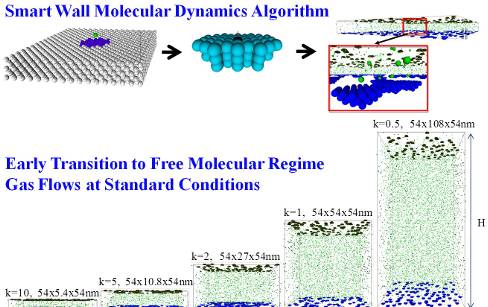Gas flows in nano-confinements are classically studied by the kinetic theory based on “dynamic similarity” between the gas flows in low pressure environments and small scale domains. However, such characterization neglects the surface force interactions between gas and wall molecules which induce variations in transport within non-negligible portions of the nano-scale confinements. By utilizing my “Smart Wall Molecular Dynamics” (SWMD) algorithm, I characterized the surface force field effects in nano-scale confined gas flows and concluded that the “dynamic similarity” simply based on Knudsen and Mach number is incomplete. In addition, MD simulations performed in a wide Knudsen range enable prediction of the Tangential Momentum Accommodation Coefficient (TMAC) which was found to be constant and independent of the Knudsen number for a specific gas/surface couple. Overall, results have a positive impact on the understanding of nano-confined gas flows by contributing first time knowledge to literature.
Releated Publications:
Book Chapters
1. Barisik M, Beskok A (2013) Encyclopedia of Microfluidics and Nanofluidics: Molecular Dynamics Studies on Nanoscale Gas Transport. Springer, New York. Accepted, in press.
Journals
1. Barisik M, Beskok A (2013) Nano-scale Gas Flows: Correct Consideration of Nano-scale Effects, in preparation.
2. Barisik M, Beskok A (2012) Surface-Gas Interaction Effects on Nanoscale Gas Flows. Microfluidics Nanofluidics, doi:10.1007/s10404-012-1000-0.
3. Barisik M, Beskok A (2011) Molecular Dynamics Simulations of Shear Driven Gas Flows in Nano-Channels. Microfluidics Nanofluidics doi:10.1007/s10404-011-0827-0.
4. Barisik M, Beskok A (2011) Equilibrium Molecular Dynamics Studies on Nanoscale-confined Fluids. Microfluidics Nanofluidics doi:10.1007/s10404-011-0794-5.
5. Barisik M, Kim B, Beskok A (2010) Smart Wall Model for Molecular Dynamics Simulations of Nanoscale Gas Flows. Communications in Computational Physics doi:10.4208/cicp.2009.09.118.

